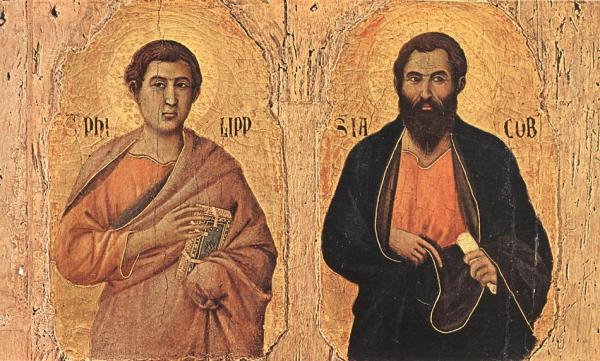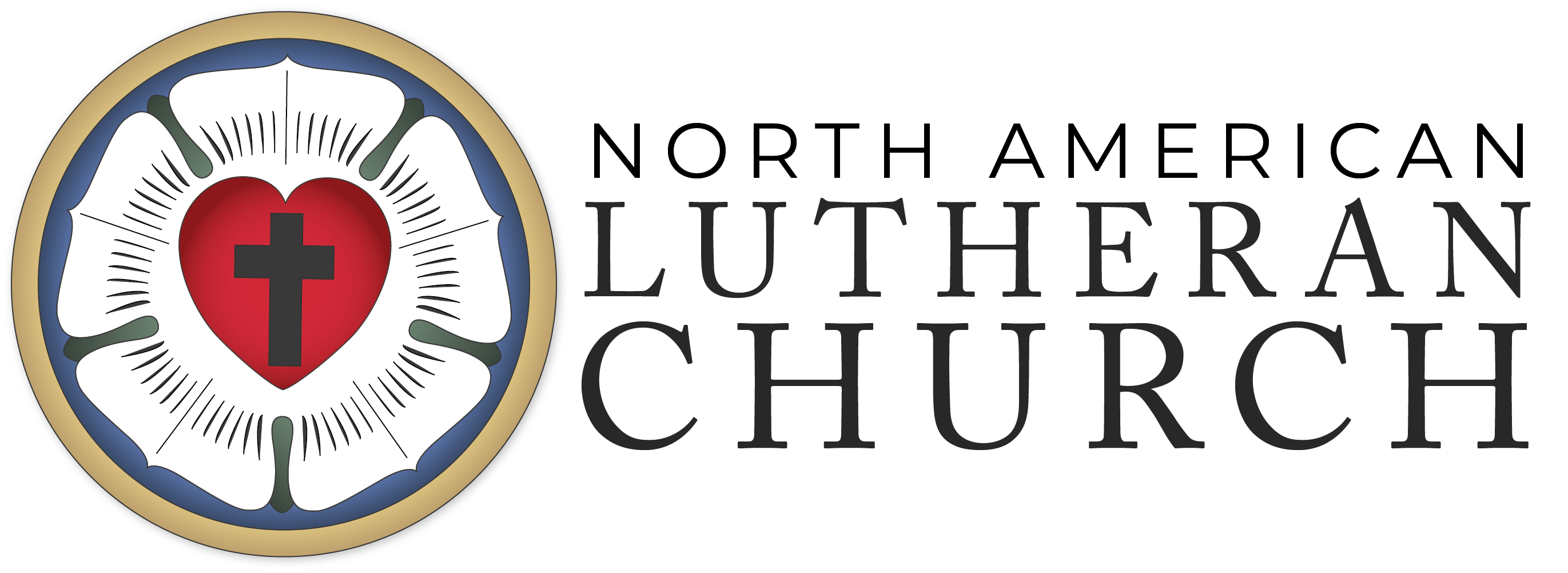
Morning Psalms
Evening Psalms
St. Philip and St. James, Apostles (May 1)

About the Festival
The Fourth Gospel provides what information we have about Philip. He was born in Bethsaida, the same fishing village on the shores of Galilee from which Peter and Andrew came. He was among the first disciples, who, after Jesus found him, found Nathanael (sometimes identified with Bartholomew; see August 24) and brought him to Jesus (John 1:43-51). Apart from his own calling, the story of Nathanael, and his inclusion in the lists of the apostles, the only other incidents of Philip’s life recorded in the Gospels are the time Jesus asked Philip how they would be able to feed the crowds (John 6:5-7), the occasion when some Greeks came to him (Philip is a Greek name) to ask his help in arranging an interview with Jesus (John 12:20-22), and his role in one of Jesus’ major discourses (John 14:8-9).
According to tradition, Philip, after Pentecost, went first to Scythia on the north coast of the Black Sea to preach the gospel, where he was remarkably successful, and then to Phrygia (in modern Turkey), where he remained until his death. He is said to have met his death in the town of Hierapolis in Phrygia, according to some accounts by crucifixion and stoning. Traditions also tell of Philip’s two unmarried daughters who survived him, lived to an old age, and were also buried in Hierapolis.
Philip the Apostle is represented in iconography by a Latin or sometimes a Tau cross, an emblem of his crucifixion, and two loaves of bread, recalling the miracle of the feeding of the five thousand (John 6:5-6).
Philip the Apostle is not to be confused with the Philip who with Stephen was a deacon in the Jerusalem church (Acts 6:5) and who is sometimes called Philip the Evangelist (see October 11).
James the son of Alphaeus is usually called James the Less (meaning either “short” or “younger”; the title derives from Mark 15:40) to distinguish him from James the Elder, the brother of John, who is commemorated July 25, and from James of Jerusalem, the brother of the Lord, who is commemorated October 2?. The only certain reference to James the Less in Scripture is the inclusion of his name in the apostolic lists. James the son of Alphaeus may be the James whose mother Mary was one of those present at the crucifixion (Matt 27:53-56 and Mark 15:40) and who had a brother named Joseph or, in the Greek form of the name, Joses.
The iconographical symbol of James the Less is a saw with which he is said by some traditions to have been dismembered or a fullers club with which, according to other accounts, he was beaten to death.
May 1 has been kept as the feast day of St. Philip and St. James since ca. 560 when on May 1 the supposed remains of the two saints were interred in the new Church of the Holy Apostles in Rome. The church was rebuilt in the fifteenth, sixteenth, and eighteenth centuries; the main altarpiece, the largest picture in Rome, is the Martyrdom of Saints Philip and James by Domenico Muratori (1661-1744).
To acknowledge the twentieth-century dedication of May 1 to labor and the working classes, Pope Pius XII in 1955 made May 1 the Feast of St. Joseph the Worker, and shifted the feast of Philip and James to May 11; the present Roman calendar (1969) moved the commemoration of the two apostles to May 3, closer to the original date. Lutherans and Anglicans have retained the traditional date. In the Eastern Churches the two apostles are commemorated separately. St. Philip’s Day is November 14, and St. James the son of Alphaeus is remembered on October 9.
Excerpts from New Book of Festivals & Commemorations: A Proposed Common Calendar of Saints by Philip H. Pfatteicher, copyright, 2008 by Fortress Press, an imprint of Augsburg Fortress.
See also: Philip the Apostle; James the Less
Reading
From The Saints in Daily Christian Life by Romano Guardini
If we were to probe a little further… we would be able to recognize the outlines of the figure of a new type of saint. It is no longer a man or woman who does exceptional things, but simply one who does what every man or woman who wishes to act well in a given situation will do. No more. No less.
To desire these things: that is true love. And in that love, let us repeat, there are limitless possibilities: that of a truth which is always to be more complete, of good always to be made more pure, of action always to be more resolute. To see in these beginnings the all of which our Lord speaks: all of the heart, all of the soul, all of the strength; to be able to see all in these humble beginnings: it is that in which sanctity consists. And this sanctity grows in the continuing struggles against oneself: in the necessary renunciations, in the challenging effort toward an ever purer sincerity of spirit and intention.
Sanctity nourished in this way is less and less an obvious thing. One could almost say that this is a deliberately hidden sanctity: one that hides its greatness, one that does things of lesser and lesser importance rightly; but by that fact they become of greater and greater significance.
The saint will no longer be characterized by extraordinary behavior (as the historian, say, understands it); he will no longer appear to the world as separated from his fellow men or above them. On the contrary, he will be doing the same thing as everyone else: what needs to be done, what is right and just. But he will join to his behavior a purity of intention more and more deeply united to a great love of God; more and more detached from selfishness and self-satisfaction.
Romano Guardini, The Saints in Daily Christian Life (Philadelphia and New York: Chilton, 1966), 56-58,61,67-68.
Propers
Almighty God, who gave to your apostles Philip and James grace and strength to bear witness to the truth: Grant that we, being mindful of their victory of faith, may glorify in life and death the Name of our Lord Jesus Christ; who lives and reigns with you and the Holy Spirit, one God, now and forever.
1979 BCP; rev. in ELW
Readings: Isaiah 30:18-21; Psalm 119:33-40; 2 Corinthians 4:1-6; John 14:6-14
Hymn of the Day: “You are the way; through you alone” (LBW 464, LSB 526, ELW 758, H82 457)
Prayers: For strength to follow Christ the way; For grace to know the truth in Christ; For courage to live the life of Christ; For all laborers and workers.
Preface: Apostles
Color: Red

This daily prayer and Bible reading guide, Devoted to Prayer (based on Acts 2:42), was conceived and prepared by the Rev. Andrew S. Ames Fuller, director of communications for the North American Lutheran Church (NALC). After a challenging year in the midst of the COVID-19 pandemic, we have been provided with a unique opportunity to revitalize the ancient practice of daily prayer and Scripture reading in our homes. While the Reading the Word of God three-year lectionary provided a much-needed and refreshing calendar for our congregations to engage in Scripture reading, this calendar includes a missing component of daily devotion: prayer. This guide is to provide the average layperson and pastor with the simple tools for sorting through the busyness of their lives and reclaiming an act of daily discipleship with their Lord. The daily readings follow the Lutheran Book of Worship two-year daily lectionary, which reflect the church calendar closely. The commemorations are adapted from Philip H. Pfatteicher’s New Book of Festivals and Commemorations, a proposed common calendar of the saints that builds from the Lutheran Book of Worship, but includes saints from many of those churches in ecumenical conversation with the NALC. The introductory portion is adapted from Christ Church (Plano)’s Pray Daily. Our hope is that this calendar and guide will provide new life for congregations learning and re-learning to pray in the midst of a difficult and changing world.
